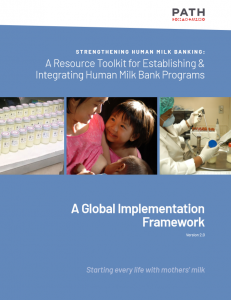
Ensuring equitable access to human milk for all infants has the potential to save countless lives, especially vulnerable neonates, such as those born low-birthweight or pre-mature. Yet many do not have access to their own mother’s milk in the first critical hours or days of life. For such infants, provision of donor human milk is recommended as superior to formula. A rigorous human milk bank system for screening, pasteurizing, storage and distribution, is required to ensure safety of donor human milk. If implemented as a component within a comprehensive and integrated system, human milk banks can also serve a broader purpose for protecting, promoting and supporting breastfeeding, embedded within both nutrition and newborn care programming.
PATH is working to strengthen systems for optimizing integrated newborn nutrition programs. A critical gap has been the lack of global standards to inform the safe, ethical and quality operationalization of human milk banks and guidance on appropriate use of donor human milk. To address this gap, PATH convened a Technical Advisory Group in 2017 to develop a roadmap for developing key resources and standards for strengthening integrated human milk banking programs. Through a highly collaborative process, involving strategic and technical input from key technical and policy leaders from around the world, PATH has developed “Strengthening Human Milk Banking: A Resource Toolkit for Establishing and Integrating Human Milk Banks” as a compendium of standards to advance the field.
This toolkit is comprised of 11 separate core documents and accompanying materials—including templates, standards, and tools—to guide critical steps for establishing human milk banking as an integrated component within breastfeeding support and neonatal care, with in-depth focus on readiness, quality assurance, operations, auditing, training, monitoring and evaluation, and communications. These tools are intended to be utilized as a cohesive package, with embedded links throughout to orient and guide users to relevant resources. This toolkit, in its entirety, is freely available and globally accessible. The content was developed to be adaptable to local context requirements to maximize effectiveness and reach.

For more information on PATH’s newborn nutrition initiative, click here.